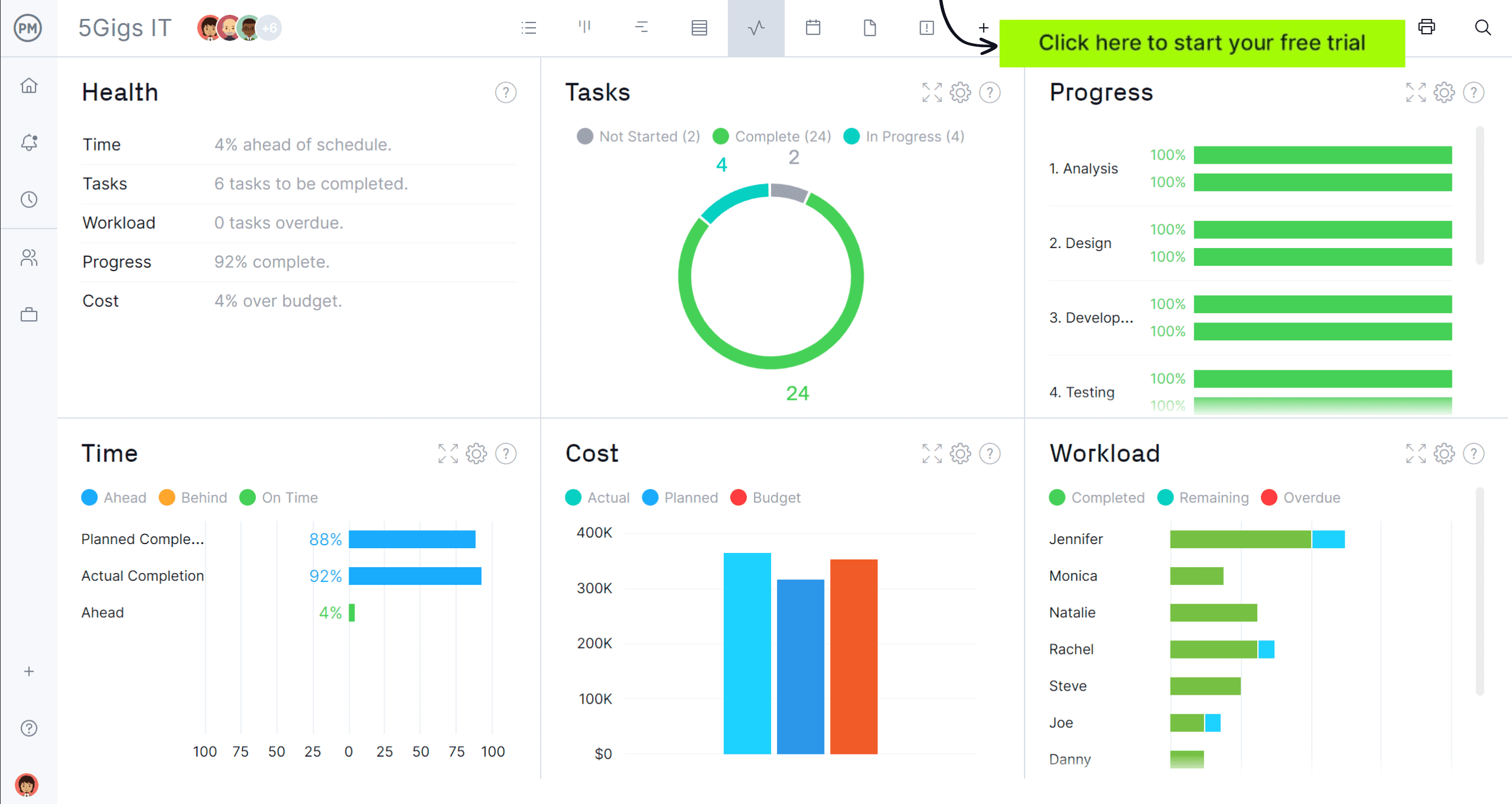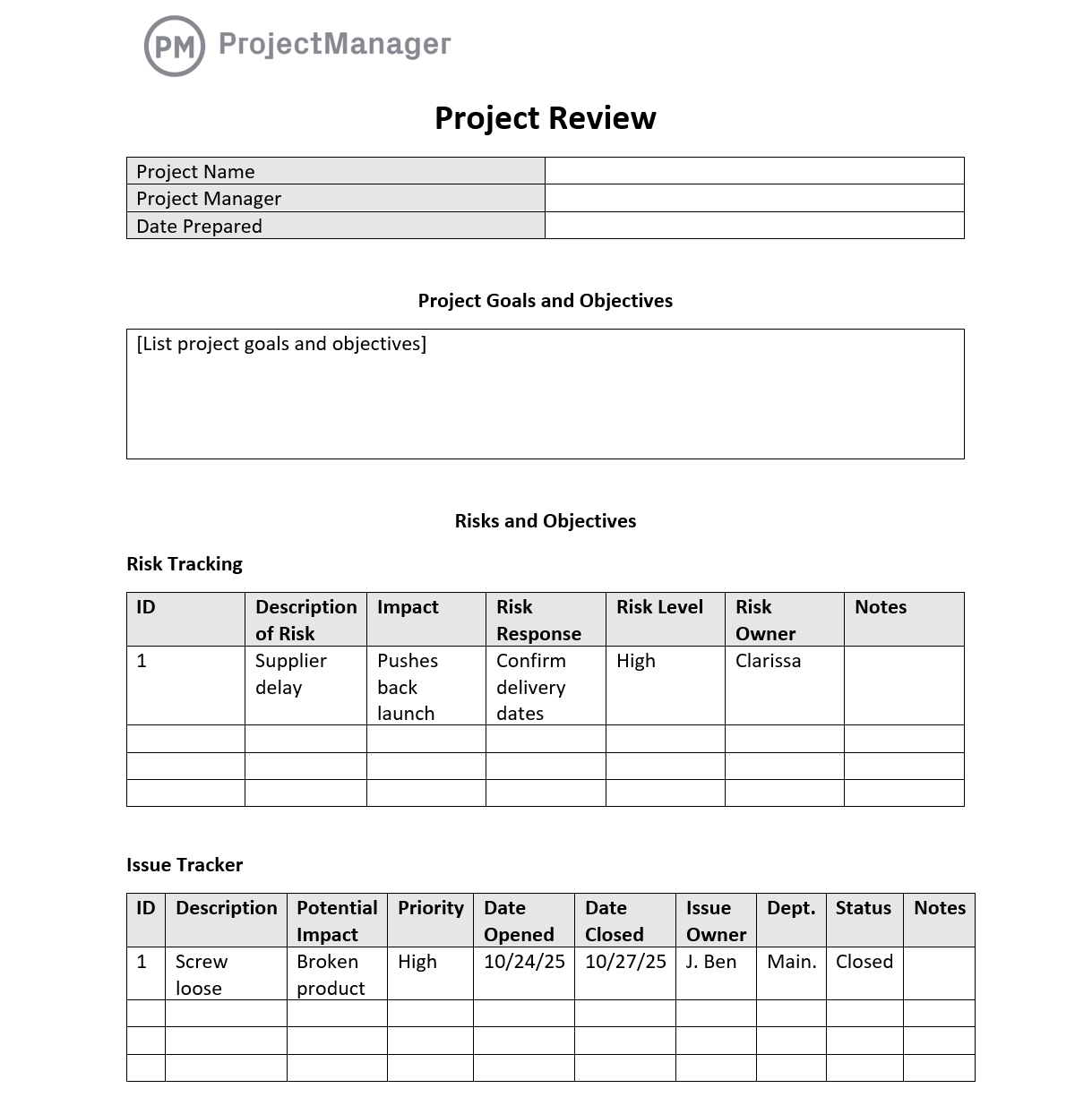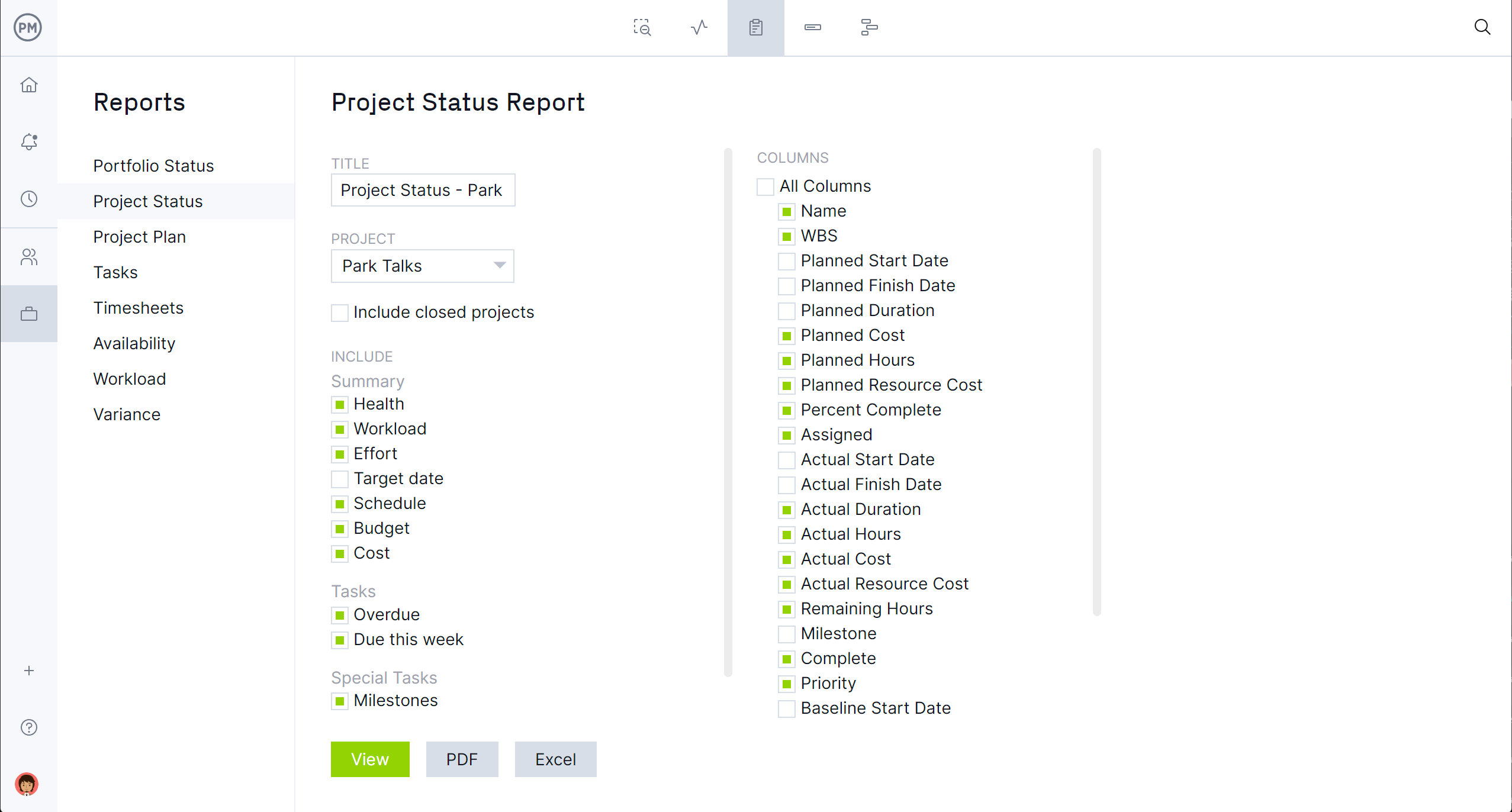Projects are planned, but for those plans to achieve their goals and for future plans to be more successful, a project review is necessary. Any project manager with even a little experience knows that rarely are plans executed without a hitch, which is why a project review process is an essential part of the monitoring and control phase of the project life cycle.
That doesn’t mean there’s only one way to do a project review. We define the term and list the types before going into how to conduct a project management review. There’s even a free project review template for Excel that readers can download and use. But we’ll show why project management software helps deliver a more efficient and effective project review.
What Is a Project Review?
A project review is a formal assessment of a project’s progress, performance and outcomes at a specific point in its life cycle. It’s used to evaluate progress to ensure that the project is on track with respect to its schedule, budget and deliverables. It does this by identifying issues, such as challenges, risks or obstacles that might hinder the project’s success.
The process includes collecting input from stakeholders, team members and sponsors to understand the project from different perspectives. This plus monitoring, helps project managers check if the project aligns with its objectives and organizational goals and meets stakeholder expectations.

Get your free
Project Review Template
Use this free Project Review Template for Word to manage your projects better.
All this work serves the purpose of making more informed decisions by providing data and insights that support better future actions. These can include adjusting the project plan or reallocating resources. These lessons learned improve the planning and execution of current and future projects.
Project management software helps to gather this data. ProjectManager is award-winning project and portfolio management software that collects real-time data to give project managers transparency into project progress and performance. For a high-level overview of one or multiple projects, use the dashboards, which automatically collect live data and display time, cost, workload and more in easy-to-read graphs and charts. It’s like an instant status report whenever you need it. Get started with ProjectManager today for free.

Types of Project Reviews
There are several types of project reviews and each serves a specific purpose. They are applied throughout the project life cycle. Here are some of the key types.
Gate Review
The gate review, often referred to as a phase gate review or stage gate review, is a structured evaluation process that occurs at certain points, or gates, in a project’s life cycle. The primary purpose of a gate review is to assess whether a project should proceed to the next phase based on predetermined criteria.
Project Performance Review
This is a systematic evaluation of a project’s progress and performance against established goals and metrics, such as the budget, risk assessment and progress. It helps stakeholders understand how well the project is meeting its objectives and allows for timely adjustments if necessary.
Post-Implementation Review
As the name implies, this evaluation is conducted after the project has been completed and its deliverables have been implemented. The primary purpose of a post-implementation review is to assess the project’s overall success and identify lessons learned for future initiatives.
Related: Free Lessons Learned Template
Benefits Realization Review
This is used to determine whether the intended benefits of a project have been achieved after its implementation. This review focuses on assessing the value delivered by the project relative to its objectives and the business case.
How to Conduct a Project Management Review
When conducting a project review, it’s important to understand project constraints, which are limitations that can impact a project’s execution and success. They typically fall into three main categories: time, cost and scope, which is referred to as the triple constraint or iron triangle. As we define the steps of a project review, keep these project constraints in mind.
1. Measure Budget Variance
One of the most important parts of a project review is the budget. The amount of funds necessary to deliver the project has been estimated, but costs can spiral out of control when executing the project. Therefore, a budget variance analysis is key. That is, the project review needs to measure the actual expenditures for the period under review and compare them to the costs forecast for this period. If there’s a discrepancy between the two, especially if costs are higher than expected at this time, then the project manager will have to make some adjustments to the triple constraint, either the schedule, budget or scope of the project.
2. Determine Whether the Project Is on or Behind Schedule
Just as was done with the budget, now it’s imperative to calculate the schedule variance. This requires looking at the schedule in the project plan and comparing it to the actual progress that has been made to date. If they align, that’s great. It’s even better if it’s ahead of schedule. But if the project is moving slower than it was scheduled to be at this period, then, again, adjustments to the triple constraint must be made to get the project back on track.
3. Review the Project Scope Baseline
The project scope baseline defines the approved version of the project scope and includes the scope statement, work breakdown structure (WBS) and WBS dictionary, which provides detailed information about each component in the WBS. It’s important for a project review as it serves as a reference point that allows project managers and stakeholders to compare current project performance against what was originally planned. It helps determine if the project is on track in terms of deliverables, for example, and helps to manage and control scope changes.
4. Monitor Resource Utilization & Availability
This step ensures that the resources in a project are being used effectively and are available when needed. It involves identifying resources and establishing utilization metrics, such as the percentage of time resources are actively working on project tasks versus available time, billable versus non-billable hours for team members and equipment usage rates. Actual utilization is then monitored to compare actual utilization against planned utilization rates.
5. Inspect the Quality of Project Deliverables
To ensure the outcomes meet established standards and stakeholder expectations, you must first define the quality criteria for deliverables and then develop quality checklists for each deliverable to ensure that all necessary aspects of the deliverable are evaluated during the review. This includes reviewing documentation, testing products and evaluating performance. If there’s an issue, then identify the root cause and recommend corrective action. Be sure to follow up on the action items to ensure that they were followed correctly. This can be part of the lessons learned aspect of a project review.
6. Track Risks and Their Mitigation Strategies
Start by establishing a risk register that describes each risk, the likelihood of it occurring, the impact on the project and who on the project team is responsible for mitigating that risk. During the project review use the risk register to assess the current status of each risk and determine if any new ones have emerged. Review the effectiveness of existing mitigation measures and if they’re being implemented as planned. When a risk shows up as an issue in the project, track it. Add a status, such as active, mitigated or resolved.
Project Review Template
That’s a lot to take in, but all of it is essential to a thorough and effective project review. To ensure that nothing falls through the cracks, download our free project review template for Word. It helps show whether the project is meeting expectations and can be used as a guide to planning upcoming projects more effectively.

Project managers and their review team can use this template to collect all the pertinent information necessary for a thorough review. Some fields define the project goals and objectives as well as a sort overview to summarize the project. This is a risk and issues overview, space for project staffing, resources, success criteria, scope baseline versus actual work completed, budget baseline against actual costs, schedule baseline compared to actual project duration, deliverables, milestones and much more.
How ProjectManager Helps with Project Reviews
While a template can act as a project review document that gathers the information found during a project review, it’s not a great tool for actually implementing the review. There’s no way to get real-time data from a template. Users have to input the data manually and it’s certainly not a collaborative document. To track the information needed to conduct a thorough project review one must use project management software, but not just any project management software. ProjectManager is award-winning project and portfolio management software with unlimited storage to centrally hold all project documentation and collect the necessary information in real time for more accurate measurements.
Use Robust Cost Tracking Features
Controlling the budget is key to delivering a successful project and a review is one tool to ensure that the project isn’t overspending. We’ve already mentioned how dashboards provide a high-level overview, but when more detail is required then use our customizable reports. There are status and portfolio reports, whether managing one or multiple projects, as well as reports on variance, workload and timesheets. Speaking of our secure timesheets, they’re also a way for managers to get visibility into labor costs.

Get Live Data From Multiple Project Management Views
Our software also has multiple project views. This allows project managers to schedule tasks, resources and associated costs on robust Gantt charts that link dependencies, filter for the critical path and set a baseline to track progress and performance in real time. Meanwhile, those plans are shared across views, such as the visual workflow kanban boards and powerful task lists, which teams can use to execute their work and log updates anywhere and at any time on our mobile app for Android and iOS. These updates are reflected on the Gantt chart, dashboards, reports and even workload charts to help balance resource use. Stakeholders can use the calendar view for a monthly overview of progress to stay updated.

Related Project Monitoring Content
Looking for more monitoring and tracking information? Below are links to a handful of recent blogs on Excel spreadsheets for tracking tasks, costs and time, project tracking software and more.
- 20 Excel Spreadsheet Templates for Tracking Tasks, Costs and Time
- Project Tracking Software – Plan & Track Projects Online
- How to Use Resource Tracking Software for Projects
- Free Lessons Learned Template for Excel
ProjectManager is online project and portfolio management software that connects teams whether they’re in the office or out in the field. They can share files, comment at the task level and stay up to date with email and in-app notifications. Join teams at Avis, Nestle and Siemens who use our software to deliver successful projects. Get started with ProjectManager today for free.



